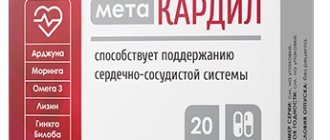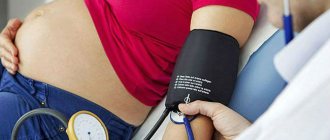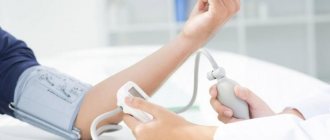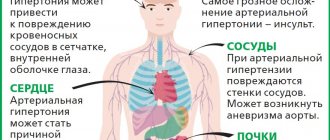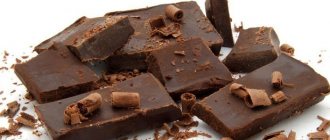Causes of the condition
When high blood pressure, the symptoms of which are pronounced, is observed against a background of high temperature (38 degrees and above), in most cases we are talking about the following painful conditions:
- cold;
- failure of the kidneys;
- thyrotoxic crisis;
- catecholamine crisis (pheochromocytoma);
- vegetative crisis.
These are the main reasons why a person has high blood pressure and fever at the same time. But each disease affects the body differently. Timely detection of the condition makes it possible to quickly react, visit a doctor and begin treatment.
Let's consider each of the pathologies in more detail.
Increased body temperature
One of the serious signs of pathology in the body is an increase in body temperature. If numbers between 36.5 - 36.9 C are considered normal, then its rise is a signal from the body that an infection or virus has entered it and inflammation has begun. Doctors recommend treating this symptom as:
- the ability of your immune system to begin fighting various irritants;
- about the onset of various disturbances in the normal functioning of internal organs, as well as body tissues.
It is for this reason that it is worth considering the various factors and causes of body temperature fluctuations.
Causes of elevated body temperature
If you have a fever, do not immediately panic and start swallowing pills or calling a doctor. It is worth knowing that some causes of elevated temperature do not pose a danger to humans. Let's look at what you should pay attention to.
Non-dangerous causes include symptoms that will go away on their own:
- if the temperature rise occurs in the evening. Very often, it is at this time that it can rise 0.5-1 degrees above normal;
- as a result of emotional or physical stress. They will increase blood circulation, and with it heat exchange will increase;
- during ovulation in women. Often before the start of the menstrual cycle, hormonal surges are possible, and with this the body temperature rises;
- as a consequence of thermal loads. The presence of a body temperature of 37 and above can manifest itself as a result of eating hot food, visiting a bathhouse or sauna, taking a bath, or after sunbathing.
And now it’s worth talking about the pathological causes that can cause dangerous diseases:
- development of acute or chronic infections;
- various viral diseases, including influenza or ARVI;
- all cases of inflammation or swelling;
- for diseases of the respiratory system;
- if there are disorders of the thyroid gland;
- in case of injury to joints and muscles;
- during the course of a sexually transmitted disease.
Symptoms of elevated body temperature
It is worth saying that a significant increase in temperature will be felt by the person himself. The main symptoms include:
- feeling tired and weak;
- chills appear. Moreover, the greater the heat, the stronger the chill will be;
- the appearance of headache;
- the appearance of body aches. The joints, muscles and fingers are most often affected;
- the person begins to feel cold;
- burning and dry eyes appear;
- the mouth feels dry;
- Appetite may decrease or disappear altogether;
- increased heart rate, arrhythmia may appear;
- sweating increases or, conversely, dry skin.
How and when to bring down a high fever in an adult
Body temperature above 38.5C should be of particular concern. And yet, doctors recommend starting to bring down the temperature with medications when it reaches 38C.
But you should focus, first of all, on your general well-being. If the high temperature is poorly tolerated, unbearable aches, chills, confusion, physical discomfort, vomiting, dizziness are felt, then the temperature should be brought down immediately.
But it also happens that even a high temperature occurs with barely noticeable discomfort, then you should focus on the thermometer mark and, if it exceeds 38.5, take an antipyretic drug.
During fever and throughout the entire period of illness, it is important to drink as much fluid as possible. Through the excretory system, it promotes the rapid elimination of bacteria and viruses and their metabolic products - toxins. As a result, you will recover faster from a high temperature.
If there is a need to bring down the temperature, it is worth adding antipyretic drugs. It is better to give preference to single-component products. Adults are recommended to take paracetamol or ibuprofen based products. The use of multicomponent drugs, where paracetamol or ibuprofen are only part of the composition, should be used in extreme cases. And even more so, exclude the joint use of both.
Pheochromocytoma
Pheochromocytoma is a rare disease. Characterized by the development of a tumor in the adrenal glands. The neoplasm, which is usually benign, produces catecholamines - hormones such as adrenaline, dopamine, norepinephrine. These hormones are the cause of hypertension against the background of elevated temperature.
Timely treatment allows you to avoid life-threatening failures in the functioning of organs and systems of the body. It is worth noting that complications of the disease most often affect the cardiovascular system.
Most often, pheochromocytoma is localized in the adrenal glands
Other symptoms of the disease:
- weakness;
- muscle cramps;
- skin redness;
- chest pain;
- blurred vision;
- nausea, sometimes to the point of vomiting.
Pheochromocytoma can affect anyone at any age, but adults aged 30–50 years are at increased risk.
To make a diagnosis of pheochromocytoma, a thorough medical examination is necessary, since the signs of the disease are varied and may indicate other pathologies.
To combat crises, nitrates, Ca channel blockers, beta blockers, and alpha adrenergic receptor blockers are used. To completely eliminate the disease, surgical removal of the formation is required. Untimely or incorrectly selected treatment for a tumor in the adrenal glands leads to hemorrhage in the brain.
Thermoregulation in the body
For normal human life it is necessary that heat exchange be carried out constantly. It depends on the characteristics of the organism and on the presence of various reflex stimuli, and changes can have an effect even if the ambient temperature remains unchanged.
Violation of thermoregulation
First of all, such violations can occur as a result of exposure to external or internal factors. For example, internal diseases include various types of diseases.
The main symptoms can be considered:
- chills;
- chills, as a result of hyperkinesis - when involuntary muscle contractions occur;
- as a result of hypothermia - the consequences of hypothermia;
- as a consequence of hyperthermia - in case of overheating of the body.
The main causes of thermoregulation disorders are:
- congenital or acquired defect of the hypothalamus. It can negatively affect the functioning of many internal organs, including body temperature itself;
- climate change. This external factor is capable of influencing body temperature as a result of adaptation of the body;
- alcohol abuse;
- a consequence of processes associated with aging;
- various mental disorders.
Thyrotoxic crisis
Hyperthyroidism is a disease in which there is excessive production of thyroid hormones. Develops due to increased functioning of the thyroid gland. Hyperthyroidism is most often diagnosed in middle-aged women.
A dangerous complication of the disease is thyrotoxic crisis, in which the increase in thyroid hormones in the blood reaches a critical value. The crisis is accompanied by disruption of the cardiovascular system and can lead to death.
Weakness, temperature of 39 degrees or more with high blood pressure are the main symptoms of the onset of a thyrotoxic crisis. Injuries, infectious diseases, and pregnancy can trigger a crisis.
Thyrotoxic crisis is a life-threatening condition that requires urgent medical attention.
Other signs of the condition:
- tremor;
- muscle weakness;
- excited state;
- atrial fibrillation;
- lack of oxygen, increased heart rate;
- nausea, vomiting, bowel dysfunction.
To improve the patient's condition, infusion thyreostatics, therapy, beta-blockers, tranquilizers, and temperature-reducing agents are used.
What not to do at high temperatures
You should react to an elevated temperature without panic, but with special care.
It is not recommended to bring it down in the first minutes after the increase; you need to let the body cope with the temperature on its own. At this time, the body’s defenses are mobilized and pathogens of various diseases die. But even when lowering the temperature, you should not strive for 36.6. In the first days of illness, this is unlikely to be achieved. Rubbing, especially with vinegar or alcohol solutions, is not recommended. However, this practice still exists at home. If a patient with a high fever is pale and his limbs are cold to the touch (so-called white hyperthermia), then any rubbing is contraindicated for him and, in addition to antipyretics, antispasmodics are recommended. The fact is that cold extremities are caused by vasospasm. And in this case, cold rubbing with vinegar or alcohol-containing liquids can only worsen the situation with the blood vessels.
Wiping with vinegar is not indicated for adults and children with respiratory manifestations of the disease or chronic pathologies of the respiratory system. Vapors can worsen the patient's condition and affect the breathing process. Also, intolerance to vinegar or alcohol, as well as the presence of damage and irritation of the skin, are contraindications to rubbing.
At high temperatures, it is not recommended to eat rich, fatty foods and sugar. An increase in glucose levels in the body reduces the number of white blood cells, which are responsible for destroying infected cells. Which can harm the process of fighting bacteria and viruses. And fatty foods create additional stress on digestion and the body devotes some of its energy to this process, instead of fighting the enemy.
Speaking about drinking liquid at a fever, it should be noted that hot drinking is strictly contraindicated! Especially coffee. Caffeine causes dehydration. A hot drink warms up the body even more. Only warm fruit drinks and herbal teas.
Kidney dysfunction
An increase in pressure against the background of an increase in body temperature may signal a failure in the functioning of the kidneys. This occurs when the kidney artery narrows, due to which the organ does not receive nutrition in the required quantity, and waste products are excreted at a slower rate.
Antihypertensive and diuretic drugs are used to treat the condition. It is also possible to widen the artery through surgery.
If the problem is caused by the tumor pressing on the tissue, then surgery to remove it is necessary. In other cases, the vessel is expanded surgically.
Prevention of hypertension development
Prevention of arterial hypertension is divided into primary and secondary. Primary prevention is needed for healthy people—those whose blood pressure does not yet exceed normal levels. The following set of health measures will help not only keep your blood pressure normal for many years, but also get rid of excess weight and significantly improve your overall well-being.
Physical exercise
Any physical exercise in persons with mild and moderate hypertension helps to increase physical performance. Exercises aimed at training endurance (general developmental exercises, breathing exercises, exercise equipment, swimming, walking, running) lead to a noticeable antihypertensive effect. However, during intense physical activity, systolic pressure increases sharply, so it is best to exercise a little (30 minutes) each day, gradually increasing the intensity from light to moderate.
Low salt diet
The amount of table salt should be limited to 5 grams (1 teaspoon) per day. It should be noted that many products (cheeses, smoked and pickled products, sausages, canned food, mayonnaise, chips) themselves contain a lot of salt. So remove the salt shaker from the table and never add salt to ready-made dishes. Replace salt with herbs and garlic. If it is difficult to do without salt, you can purchase salt with a reduced sodium content, the taste of which is almost no different from regular salt.
Limiting animal fats
Gradually replace butter, cheeses, sausages, sour cream, lard and fried cutlets from your diet with additional vegetables and fruits, vegetable oil and lean fish. Prefer low-fat dairy products. This way you can control cholesterol levels in the blood (prevention of atherosclerosis), normalize weight and at the same time enrich your diet with potassium, which is very useful for hypertension.
Rejection of bad habits
Enough has been said about the dangers of tobacco and alcohol. But if you find more than two of the risk factors for hypertension listed above, know that it’s time to be more merciful to your heart and blood vessels. Bad habits and arterial hypertension are a terrible combination, which in most cases leads to tragic consequences.
If the diagnosis of “hypertension” has already been made, a few more points should be added to the above measures. This is the so-called secondary prevention, the main task of which is to protect target organs from negative consequences and avoid the dangerous complications of hypertension - coronary heart disease, heart attack, cerebral stroke.
Psychological relief
Stress is one of the main causes of high blood pressure. That’s why it’s so important to master methods of psychological relief - auto-training, self-hypnosis, meditation. It is important to strive to see the positive sides in everything, to find joy in life, to work on your character, changing it towards greater tolerance for other people’s shortcomings, optimism, and balance. Hiking, sports, hobbies and spending time with pets also help maintain mental balance.
Blood pressure measurement
Blood pressure must be measured daily, and the resulting numbers must be written down in a special notebook, which must be shown to your doctor every 2-3 months. Secondary prevention of hypertension consists of individual selection of appropriate doses of antihypertensive drugs and systematic maintenance of normal or near-normal blood pressure values with their help.
Non-drug therapy
In addition to the already mentioned hypertensive diet, therapy may include breathing exercises, light massage, normalization of sleep, adherence to a daily routine, taking natural and synthetic vitamins, antioxidants, nutritional supplements and restorative herbs. In short, it’s worthwhile to “improve” your lifestyle as much as possible.
Vegetative crisis
A vegetative crisis is often accompanied by panic attacks. A crisis is characterized by the occurrence of an unreasonable attack of anxiety and fear that lasts several minutes.
The condition is common among people aged 25–40 years. Can be triggered by stress, abuse of tonic drinks. More common in women than men.
Symptoms of the main types of vegetative crises
Symptoms of a panic attack:
- difficulty breathing;
- increased heart rate (tachycardia);
- chest pain;
- trembling throughout the body, similar to chills;
- increased sweating;
- weakness;
- dizziness, headache;
- discomfort in the abdominal area;
- nausea, vomiting.
Blood pressure and temperature may change during the attack. High blood pressure can be observed against the background of low body temperature and vice versa.
At the end of the attack, uncontrolled urination or defecation is possible.
In some cases of autonomic disorder, there may be high blood pressure and low temperature. Low body temperature during an attack is accompanied by drowsiness.
To relieve panic attacks, experts prescribe tranquilizers, antidepressants, and beta-blockers. It is also recommended to adhere to a healthy lifestyle and deal with stress.
How to prevent pressure surges?
People prone to pressure surges in the heat must adhere to the following rules:
- Minimize the time spent on the street between 11 a.m. and 5 p.m.;
- Wear loose clothing made from natural light fabrics and a hat;
- Regularly measure your blood pressure using a home blood pressure monitor to determine how your blood pressure changes when the air temperature rises;
- Do not stay in direct sunlight for a long time;
- Eliminate intense physical activity, opting for leisurely walks on the shady side of the street;
- Control the air humidity in the room - the indicator should not fall below 60%;
- Eliminate fatty and smoked foods and alcohol from the diet;
- Stay calm and avoid nervous tension.
If weather forecasters promise heat, you should consult a doctor in advance to clarify the dosage of medications in such situations, the possibility of using herbal remedies, the need to take medications that thin the blood and prevent the formation of clots.
Diagnosis of the problem
Treatment will be effective if the patient is thoroughly examined and the doctor gives him an accurate diagnosis. You can get rid of elevated indicators only by eliminating the cause of the phenomenon.
The following stages of diagnosing the disease with these symptoms are distinguished:
- Questioning the doctor about complaints, general examination.
- Determination of blood pressure and temperature using appropriate instruments.
- An appointment for tests to determine the amount of hormones, as well as the condition of the liver and kidneys.
- MRI.
- Electrophysiological study of cardiac activity.
At the request of the doctor, the diagnostic stages can be supplemented. Having received the research results, the pathology is determined.
Treatment options
Regardless of the treatment method, the disease is not transmitted to the legs. A man takes a pill and continues to work, not realizing how it overloads an already overloaded body. Treatment should be comprehensive and include, in addition to medications, proper diet and rest. There will always be work, but a person has only one life. Therefore, with high blood pressure, 3-4 days of bed rest will give you several years of healthy life.
Medicines
Despite such a symptom as hypertension during a cold, traditional treatment is used. Drug treatment includes taking tablets, using drops and powders. If body temperature is below 38 ° C, it cannot be lowered. The body itself fights the virus, trying to restore normal functioning of the organs.
If the temperature rises and a person with hypertension feels worse, it is lowered with the help of medications. Typically, tablets or syrup are used.
Aspirin or Paracetamol are good for this. Contraindications for this condition are drugs such as Panadol. They are prohibited because they contain caffeine.
It is allowed to combine drugs and take several types at the same time. You can also take vitamin C to relieve fever while rinsing your nose with mucus. In this case, vitamin C serves as an addition to the main treatment. It will be much better if the patient takes a course of complex vitamin preparations. This approach will ensure that all beneficial ingredients are absent from a cold, and the patient will recover faster.
Traditional methods
In addition to pharmacological treatment, traditional medicine is also used. They cannot act as separate treatments. Simple recipes improve the health of the body by getting rid of cold symptoms, but they do not kill viruses. Treatment methods:
- Cranberry. Most effective against viral infections. Restores the functionality of all internal organs. Supports the body in the fight against microorganisms.
- Berries against colds. Many fruits are rich in vitamins and are recommended for colds. The most effective are considered to be rose hips, raspberries and currants. Not only berries are used, but also twigs and leaves.
- Honey. A natural cold remedy that can be added to tea.
- Inhalation. A simple procedure helps get rid of a runny nose and cleanse the mucous membranes in the nasal cavity. Freshly boiled potatoes, fir and essential oils are suitable for inhalation.
Although all the above methods are completely natural, they can be harmful to your health. Before using them, be sure to consult your doctor. This ensures that the person does not encounter a negative reaction from the body.
Fever and headache
Headaches in the summer heat are often a consequence of dehydration. With a lack of fluid, the blood supply to the brain, which consists of 90% water, deteriorates. If your head begins to hurt at the same time as a feeling of tightness in the chest and lack of air, shortness of breath and increased heart rate, this may indicate problems with the heart.
Help relieve headaches in hot weather:
- Cool shower or foot bath;
- Cold compress on forehead;
- Peace and quiet;
- Lack of bright light;
- Rest in a supine position on a high pillow;
- Compliance with the drinking regime (you can drink water with lemon).
If the situation worsens, you should consult a doctor. A headache may be a sign of sunstroke. If it is accompanied by vomiting, it is a dangerous condition and requires medical attention.

